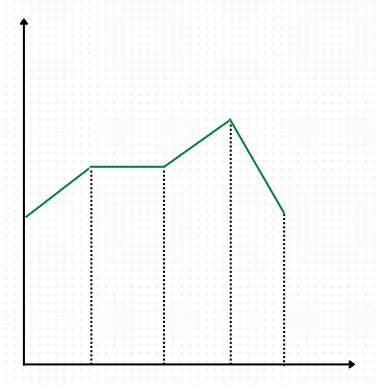Determine whether the given Array forms a valley or not
Last Updated :
11 Jan, 2023
Given an array arr[] of length N, the task is to check whether the given array forms a valley or not. An array is said to be a valley if there is a point till which the array is non-increasing and after that increases in nature. Formally arr[0] ? arr[1] ? . . . ? arr[i] ? arr[i+1] ? . . . ? arr[N-1] and arr[0] > arr[i] and arr[i] < arr[N-1], where i is any index in the range [1, N-2].
Note: An array with only a single element is also considered to be a valley.
Input: N = 6 arr[] = {5, 4, 4, 3, 2, 2}
Output: No

Not a valley
Input: N = 8 arr[] = {5, 4, 4, 3, 4, 4, 5, 6}
Output: Yes

valley representing given input
Input: N = 5 arr[] = {4, 5, 5, 6, 4}
Output: No

array doesn’t form a valley
Approach: The problem can be solved using linear iteration based on the following idea:
Find any index i, such that all the elements before that are in non-increasing order and after that all the elements are in non-decreasing order.
Follow the steps to solve the problem:
- Traverse from the start to the index (say idx) where the current element becomes greater than the previous.
- From that index traverse till the end and check if they are in non-decreasing order.
- Finally, check if arr[idx-1] is less than both arr[0] and arr[N-1].
- If the above conditions are satisfied, return “Yes”. Otherwise, the array does not form a valley.
Below is the code for the discussed approach:
C++
#include <bits/stdc++.h>
using namespace std;
int isValley(vector<int>& a, int n)
{
int idx = 0;
for (int i = 1; i < n; i++) {
if (a[i] > a[i - 1]) {
idx = i;
break;
}
}
if (idx == 0)
return 0;
for (int i = idx + 1; i < n; i++) {
if (a[i] < a[i - 1])
return 0;
}
if (a[idx - 1] >= a[0] or a[idx - 1] >= a[n - 1])
return 0;
return 1;
}
int main()
{
vector<int> arr = { 5, 4, 4, 3, 2, 2 };
int N = arr.size();
int sol = isValley(arr, N);
if (sol)
cout << "Yes\n";
else
cout << "No\n";
return 0;
}
|
Java
import java.io.*;
class GFG {
static boolean isValley(int[] a, int n)
{
int idx = 0;
for (int i = 1; i < n; i++) {
if (a[i] > a[i - 1]) {
idx = i;
break;
}
}
if (idx == 0) {
return false;
}
for (int i = idx + 1; i < n; i++) {
if (a[i] < a[i - 1])
return false;
}
if (a[idx - 1] >= a[0] || a[idx - 1] >= a[n - 1])
return false;
return true;
}
public static void main(String[] args)
{
int[] arr = { 5, 4, 4, 3, 2, 2 };
int N = arr.length;
boolean sol = isValley(arr, N);
if (sol) {
System.out.println("Yes");
}
else {
System.out.println("No");
}
}
}
|
C#
using System;
class GFG {
static bool isValley(int[] a, int n)
{
int idx = 0;
for (int i = 1; i < n; i++) {
if (a[i] > a[i - 1]) {
idx = i;
break;
}
}
if (idx == 0) {
return false;
}
for (int i = idx + 1; i < n; i++) {
if (a[i] < a[i - 1])
return false;
}
if (a[idx - 1] >= a[0] || a[idx - 1] >= a[n - 1])
return false;
return true;
}
public static void Main()
{
int[] arr = { 5, 4, 4, 3, 2, 2 };
int N = arr.Length;
bool sol = isValley(arr, N);
if (sol) {
Console.Write("Yes");
}
else {
Console.Write("No");
}
}
}
|
Javascript
function isValley(a, n)
{
let idx = 0;
for (let i = 1; i < n; i++) {
if (a[i] > a[i - 1]) {
idx = i;
break;
}
}
if (idx == 0)
return 0;
for (let i = idx + 1; i < n; i++) {
if (a[i] < a[i - 1])
return 0;
}
if (a[idx - 1] >= a[0] || a[idx - 1] >= a[n - 1])
return 0;
return 1;
}
let arr = [5, 4, 4, 3, 2, 2];
let N = arr.length;
let sol = isValley(arr, N);
if (sol)
console.log("Yes");
else
console.log("No");
|
Python3
def isValley(a, n):
idx = 0
for i in range(1, n):
if a[i] > a[i - 1]:
idx = i
break
if idx == 0:
return 0
for i in range(idx + 1, n):
if a[i] < a[i - 1]:
return 0
if a[idx - 1] >= a[0] or a[idx - 1] >= a[n - 1]:
return 0
return 1
arr = [5, 4, 4, 3, 2, 2]
N = len(arr)
sol = isValley(arr, N)
if sol:
print("Yes")
else:
print("No")
|
Time Complexity: O(N)
Auxiliary Space: O(1)
Related Articles:
Share your thoughts in the comments
Please Login to comment...